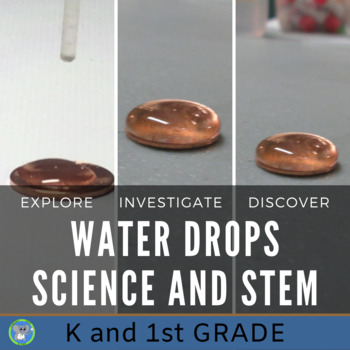Water Drops On A Penny Experiment | Properties of Matter | Grade K 1 Science
- PDF
- Easel Activity
Also included in
- Do you know how many drops of water can fit on a Penny? What if we change the water? Bundle and save with all 3-grade level versions. Investigations, explorations, and STEM Challenge Included. You get 3-grade levels which makes it perfect for the science/STEM teacher and differentiating. We willPrice $12.80Original Price $16.00Save $3.20
Description
Explore water drops with this engaging hands-on exploration. This classic experiment uses inexpensive supplies and is easy to set up. Introduce the scientific method, practice counting, and learn how to observe in science. Teacher directions and background information included to increase success.
It makes a fun coin experiment you can do on Saint Patrick's Day too.
The students will follow the scientific method to demonstrate that a penny can hold many drops of water. They will investigate that water likes to stick or cling together and soap breaks that bond. It is a great way to get students thinking about matter in small parts called molecules. We like to integrate it for fire safety. Students will learn that firemen must use special water to fight fires. Students will enjoy the further exploration to apply their new knowledge. They will never look at water the same way. Chances are they will be asking mom and dad for pennies when they get home from school.
Distance Learning Approved. This is a great way to get students to use the scientific method at home. The supplies are simple and can easily be modified. The file is a PDF, but comes with a pre-created overlay in Easel by TpT. We added text boxes and tips for completing it online. Click "Open in Easel" to get started. It will also allow you to make modifications. It can be added to your Google Classroom as an assignment. Students can also print and complete. A science lab teacher can assign all the grade levels which allows families to conduct the experiment together. See the bundle for all three versions. If you don't have Google Classroom you can send as an email link with Google accounts. If that is not available you will need a program like Kami extension to create an online version from the PDF with text boxes. We already did it for you in Easel. You could conduct the experiment as a demo for the students and then they try it. Get creative! Just remember this activity uses water and students need to be careful by their device.
By the end of the activities student’s can answer the question:
Does soap affect the number of water droplets that can fit on a penny?
The journal meets the Next Generation Science Standards
- Grade K-2 Science and Engineering Practices
Teachers will like its’ ease of use, simple materials, and background information. We will guide you step by step. The journal is very age-appropriate. It would work well as a center. Teachers can easily adjust their explanations and adjust as needed. The further exploration activity will help teachers expand the lesson and make it more engaging. Teachers will feel confident about teaching the lesson because we provide lots of background and guidance. We estimate 2-3 class periods to complete all the activities.
This hands-on Investigation and teacher guide includes:
- Background Information
- Tips for Success
- Anchor charts to help with discussions.
- My Investigation on Water Drops Journal
- Further Exploration Activity
- CER Page for a whole class discussion.
- Rubric
- Answer Key
Supplies Needed:
Measuring Cups, Clean Pennies, Dish Soap, Eyedroppers, Paper Towels, Water, Cups,
Permanent Marker, other liquids for further exploration
Great for the classroom, science fairs, STEM Fairs, science clubs, scout groups, center time, home school, and anyone wanting to learn the science of water.
This investigation is part of a series. This is the K/1st grade investigation. 2nd/3rd and 4th/5th grade are also available. Each version is differentiated for abilities and the Next Generation Science Standards. K/1st grade tests with and without soap and includes a further exploration activity. 2nd/3rd grade increases the amount of soap, includes a further exploration activity, and a STEM challenge. 4th/5th grade increases the amount of soap one more level, completes 3 trials, and increases the expectation. It also includes the further exploration activity and STEM challenge. We hope your students have a wonderful experience exploring the properties of water and the science of surface tension.
All are available for a bundle discount.
Properties of Water: Investigate Surface Tension with 2nd/3rd Grade
Properties of Water: Investigate Surface Tension With 4th/5th Grade
You might also like
Cloud In A Bottle Experiment: A Kindergarten And First Grade Science Project
Investigate Glow Stick Brightness With Grades K-1
States Of Matter Exploration: Discover Solids, Liquids, And Gases
Remember leaving feedback earns you points toward FREE TPT purchases. We love hearing how the investigation went.
Also, follow us and be notified when new explorations are uploaded and deals.
Please contact me with any questions! We are here to help.
Yours in Science,
Kimberly Scott
All parts are copyrighted. Please see the Terms of Use in the Download







